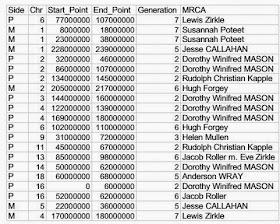 |
| My Mom's Segment Chart. I found I can add segments using Paint shapes |
Last week I said that I had found a very low confidence match at AncestryDNA who shared a 20 cM segment, and the others I looked at, in that confidence range, shared 10 cM segments. This week I was contacted by a very low confidence match who shared only one 6 cM segment. That doesn't sound like a very promising match? As it turned out she also matched my mother at FTDNA, and shared much more DNA with her. She shared a 28 cM segment with her. I looked at her Ancestry.com tree and found a Rhea on it. I then did more research to see whether her Rhea might be related to our Wrays? I did find that her Rhea ancestor was indeed related to our Wrays. I also found another Rhea matching on the same segment. So very low confidence matches sharing small amounts of DNA can be related. It just takes verification through a stronger match with another proven relative.

Lucky I was able to compare with my latest AncestryDNA match before the site went down for a few weeks. Here is their statement about the site status:
"GEDmatch temporarily down. As most of you know, website reliability has been an ongoing problem. In an effort to improve reliability, we are starting the process of changing the location of our servers. It is anticipated that this transition may take at least a couple of weeks. Thank you for your patience and support during this process. As we know more about an anticipated restoration date, we will post that information here. Please do not send emails asking when the site will be back online."
I'm hoping I don't need to do another comparison until the site is back up again; if I do then it's going to be a long wait.
Another DNA project I have been working on this week is at Genome Mate. I happened to see this announcement from the software developer:
"Expanded the Segment List to show a chromosome map and added an export button to format data for use in Kitty's mapper. Click on Segments on the main page."
So I went ahead and highlighted all my match segments properly by selecting the ancestor our lines match through, and also selecting the Paternal or Maternal radio buttons. I did all of this for both my Mom and myself. After completing this I found I was not able to download a CSV file to use for
Kitty's mapper? So I went back to Facebook to look for more information and found this:
"Segments need to be marked as permanent before they can be exported. I often will mark a segment but not make it permanent until I have it triangulated."
So I went back and couldn't find a button to mark the segments as permanent. I went back to Facebook again and found more instructions. You need to right click on the segments in the segment map, which takes you to a dialog box with the save button. So I finally got it downloaded and went over to the
Kitty's mapper site. I then discovered it wouldn't work because the formatting wasn't correct and the full segment numbers weren't included. So if I want to use the
Genome Mate's CSV file with
Kitty's mapper I need to add the information. I decided that would be too time consuming. I might as well just download to information from FTDNA 5 matches at a time them combine it all in one CSV file. I may do this when I get a chance.
I did manage to accomplish a great deal DNA wise this week. Now I have another Wray cousin. After some triangulation I also managed to find more likely Wray matches. I have segment maps at
Genome Mate. I also have another Irish match at FTDNA. This match has ancestors from Tuam, Galway, Ireland. Two other matches share the same segment; a third shares a segment with one of them. One of these matches is adopted so this new match should provide her with more ancestral origin information. My Mullen family came from the Tuam area of Galway, so this is probably a IBD match.
I'm looking forward to the streaming sessions from
Jamboree which begin on Thursday. The first day is DNA day, and there is a $30 per session charge for viewing. The next 3 days are free.
 |
| My segment chart. |















